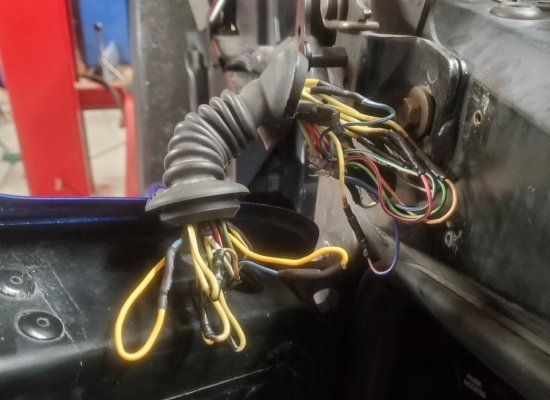Tom and Vipers
Enthusiast
12 volt source:
It was an early 96 GTS install with the BK/OR wire as 12V source.
BK/OR is 12v in the RUN position only.
Roe's installation manual revised the BK/OR Run wire to the DB (Dark Blue) RUN & START wire.
WHY?
I can see issues with the RUN-START-RUN cycle which if BK/OR, energizes the VEC1, they de-energizes during START, then re-energizes finally in RUN (engine running.)
I see 2 considerations:
*) Interrupting VEC1 energizing during START could pose issues.
*) During START, battery voltage is drawn down by starter: this could cause VEC1 low-voltage issues
Why did Roe revise to use the DB wire (RUN & START)?
Power to VEC1 is continuous during engine start up.
BV still has the early BK/OR 12v source.
What are the issue(s) with this and should I change it to DB (I'll just an Add-A-Fuse in the fuse block.)
Never thought of this until a few days ago:
There is no BARO sensor.
PCM measures BARO from the MAP during Key-On.
NOTE: I think it was HexDummy on HPTuners forum that mentioned PCM will update BARO from MAP under certain conditions. One way might be: WOT @ Low RPM: MAP should be just slightly lower than atmospheric. If this value is higher than the Key-On, it would be safe to update BARO.
NOTE: Also, BARO is only used for the pressure at the end of the exhaust system. Giving a ΔP across the engine.
Now we have a race between the VEC1 coming up and the PCM measuring the MAP.
Who wins and if VEC1 translation is in effect when PCM measures BARO, what then?
QUESTION: What happens if the VEC1 (and A/F display) loses 12v power:
QUESTION: Clearly sensor connections should be soldered, but the VEC1/AF are electronics with high impedance - is it possible the 25 year old 12v source vampire clips could become noisy or fail?
It was an early 96 GTS install with the BK/OR wire as 12V source.
BK/OR is 12v in the RUN position only.
Roe's installation manual revised the BK/OR Run wire to the DB (Dark Blue) RUN & START wire.
WHY?
I can see issues with the RUN-START-RUN cycle which if BK/OR, energizes the VEC1, they de-energizes during START, then re-energizes finally in RUN (engine running.)
I see 2 considerations:
*) Interrupting VEC1 energizing during START could pose issues.
*) During START, battery voltage is drawn down by starter: this could cause VEC1 low-voltage issues
Why did Roe revise to use the DB wire (RUN & START)?
Power to VEC1 is continuous during engine start up.
BV still has the early BK/OR 12v source.
What are the issue(s) with this and should I change it to DB (I'll just an Add-A-Fuse in the fuse block.)
Key-On BARO:
Never thought of this until a few days ago:
There is no BARO sensor.
PCM measures BARO from the MAP during Key-On.
NOTE: I think it was HexDummy on HPTuners forum that mentioned PCM will update BARO from MAP under certain conditions. One way might be: WOT @ Low RPM: MAP should be just slightly lower than atmospheric. If this value is higher than the Key-On, it would be safe to update BARO.
NOTE: Also, BARO is only used for the pressure at the end of the exhaust system. Giving a ΔP across the engine.
Now we have a race between the VEC1 coming up and the PCM measuring the MAP.
Who wins and if VEC1 translation is in effect when PCM measures BARO, what then?
Power Loss & Vampire Clips:
QUESTION: What happens if the VEC1 (and A/F display) loses 12v power:
QUESTION: Clearly sensor connections should be soldered, but the VEC1/AF are electronics with high impedance - is it possible the 25 year old 12v source vampire clips could become noisy or fail?

